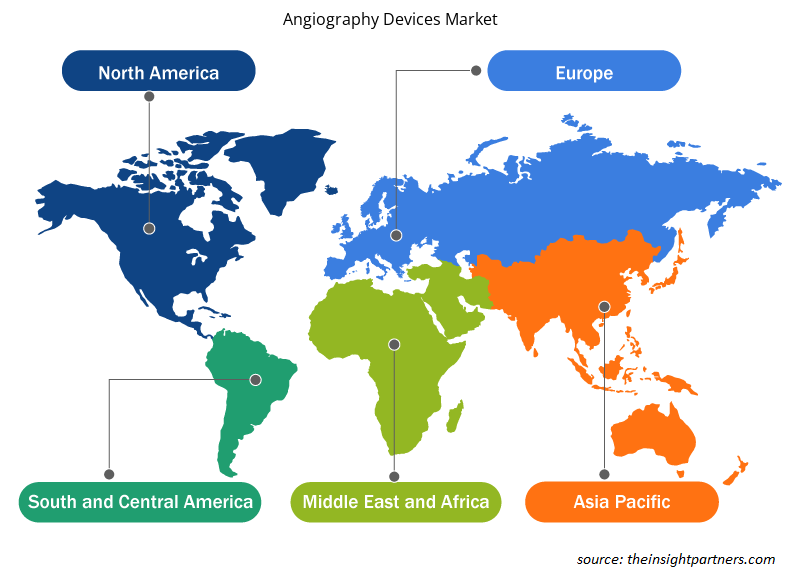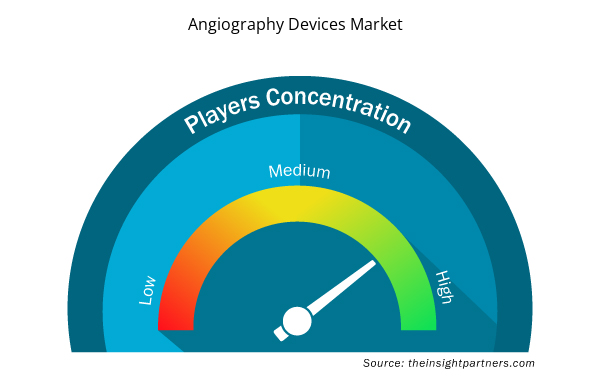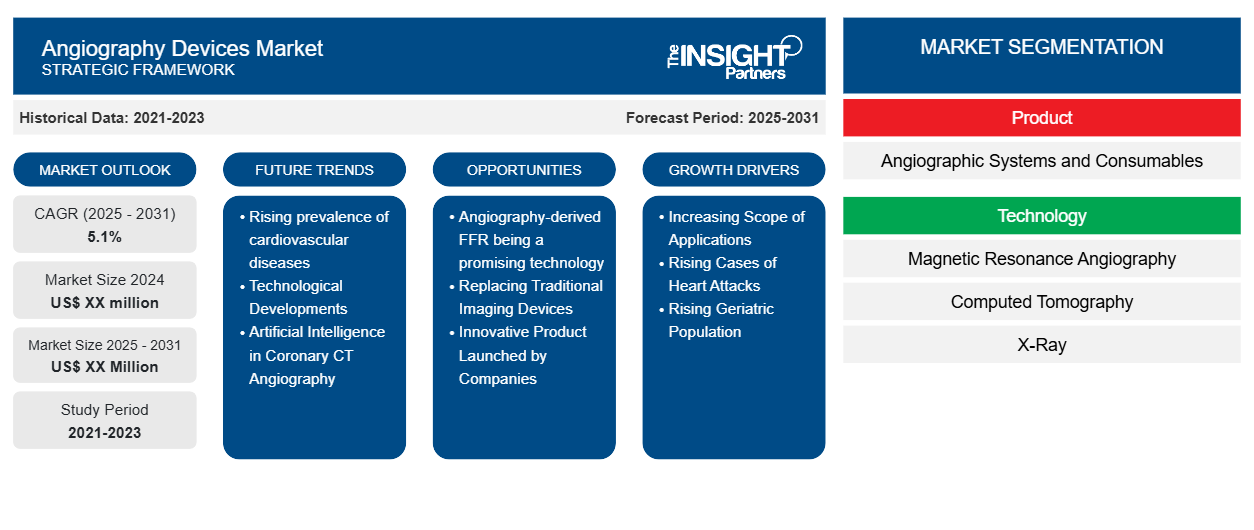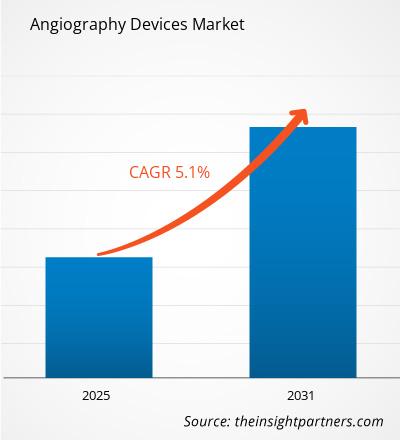Le marché des appareils d'angiographie devrait enregistrer un TCAC de 5,1 % de 2024 à 2031, avec une taille de marché passant de XX millions USD en 2024 à XX millions USD d'ici 2031.
Le rapport est segmenté par marché des appareils d’angiographie par produit (systèmes et consommables angiographiques), technologie [angiographie par résonance magnétique (ARM), tomodensitométrie (TDM), rayons X et autres technologies)], procédure (angiographie coronarienne, micro-angiographie, angiographie non coronarienne et autres), application (diagnostique et thérapeutique), indication (cardiopathie congénitale, insuffisance cardiaque congestive, cardiopathie valvulaire, coronaropathie connue et suspectée (CAD) et autres), utilisateur final (hôpitaux, centres de diagnostic, centres de chirurgie ambulatoire et laboratoires de recherche universitaires) et géographie (Amérique du Nord, Europe, Asie-Pacifique, Moyen-Orient et Afrique, et Amérique du Sud et centrale). L’analyse globale est ensuite décomposée au niveau régional et par principaux pays. Le rapport offre la valeur en USD pour l’analyse et les segments ci-dessus.
Objectif du rapport
Le rapport sur le marché des appareils d'angiographie de The Insight Partners vise à décrire le paysage actuel et la croissance future, les principaux facteurs moteurs, les défis et les opportunités. Cela fournira des informations à diverses parties prenantes commerciales, telles que :
- Fournisseurs/fabricants de technologie : pour comprendre l’évolution de la dynamique du marché et connaître les opportunités de croissance potentielles, leur permettant de prendre des décisions stratégiques éclairées.
- Investisseurs : Effectuer une analyse complète des tendances concernant le taux de croissance du marché, les projections financières du marché et les opportunités qui existent tout au long de la chaîne de valeur.
- Organismes de réglementation : Réglementer les politiques et surveiller les activités du marché dans le but de minimiser les abus, de préserver la confiance des investisseurs et de maintenir l’intégrité et la stabilité du marché.
Segmentation du marché des appareils d'angiographie
Produit
- Systèmes et consommables angiographiques
Technologie
- Angiographie par résonance magnétique
- Tomodensitométrie
- Radiographie
- Autres technologies
Procédure
- Angiographie coronaire
- Micro-angiographie
- Angiographie non coronarienne
- Autres
Application
- Diagnostique
- Thérapeutique
Indication
- Maladie cardiaque congénitale
- Insuffisance cardiaque congestive
- Valvulopathie cardiaque
- Maladie coronarienne connue et suspectée
Personnalisez ce rapport en fonction de vos besoins
Vous bénéficierez d'une personnalisation gratuite de n'importe quel rapport, y compris de certaines parties de ce rapport, d'une analyse au niveau des pays, d'un pack de données Excel, ainsi que d'offres et de remises exceptionnelles pour les start-ups et les universités.
- Obtenez les principales tendances clés du marché de ce rapport.Cet échantillon GRATUIT comprendra une analyse de données, allant des tendances du marché aux estimations et prévisions.
Facteurs de croissance du marché des appareils d'angiographie
- Champ d'application croissant : les appareils d'angiographie sont utilisés pour vérifier la santé des vaisseaux sanguins et la façon dont le sang les traverse. Ils peuvent aider à diagnostiquer ou à étudier plusieurs problèmes affectant les vaisseaux sanguins, notamment : l'athérosclérose - rétrécissement des artères. Ils permettent de réaliser des interventions chirurgicales mini-invasives complexes et délicates.
- Augmentation des cas de crises cardiaques : l'augmentation de la prévalence des crises cardiaques devrait stimuler la croissance du marché. Selon les Centres pour le contrôle et la prévention des maladies (CDC), environ toutes les 40 secondes, un Américain subit une crise cardiaque. Chaque année, 805 000 Américains sont victimes d'une crise cardiaque, dont 605 000 pour la première fois. Environ 12 % des personnes victimes d'une crise cardiaque en mourront.
- Augmentation de la population gériatrique : la population âgée de 60 ans et plus était estimée à 1 milliard en 2020. D'ici 2050, la population mondiale de personnes âgées de 60 ans et plus doublera (2,1 milliards). Le nombre de personnes âgées de 80 ans et plus devrait tripler entre 2020 et 2050 pour atteindre 426 millions.
Tendances futures du marché des appareils d'angiographie
- Prévalence croissante des maladies cardiovasculaires : le nombre annuel de décès dus aux maladies cardiovasculaires (MCV) en Inde est passé de 2,26 millions (1990) à 4,77 millions en 2020. Les taux de prévalence des maladies coronariennes en Inde ont été estimés au cours des dernières décennies et ont varié de 1,6 % à 7,4 % dans les populations rurales et de 1 % à 13,2 % dans les populations urbaines en 2023.
- Progrès technologiques : L'angiographie par tomodensitométrie (CT) est une technologie innovante utilisée comme alternative aux tests de stress. L'angiographie coronaire CT est un examen diagnostique non invasif qui permet de déterminer la présence, la quantité et la gravité de la plaque d'athérosclérose dans les artères du cœur. L'équipement essentiel nécessaire à l'angiographie conventionnelle comprend : Un ensemble de cathéters et de fils-guides.
- Intelligence artificielle dans l'angiographie coronarienne par tomodensitométrie : les maladies coronariennes sont la principale cause de mortalité dans le monde. La détection et le traitement précoces des maladies coronariennes sont essentiels. Actuellement, l'angiographie coronarienne par tomodensitométrie (CCTA) est le premier choix pour le dépistage et le diagnostic des maladies coronariennes, mais elle ne peut pas répondre aux besoins cliniques en termes de qualité d'examen et de précision des rapports, ni de précision de l'analyse pronostique. Ces dernières années, l'intelligence artificielle (IA) s'est développée rapidement dans le domaine de la médecine ; elle a joué un rôle clé dans le diagnostic auxiliaire, l'analyse des mécanismes de la maladie et l'évaluation du pronostic, notamment dans une série d'études liées aux maladies coronariennes.
Opportunités de marché pour les appareils d'angiographie
- La FFR dérivée de l'angiographie est une technologie prometteuse : La FFR dérivée de l'angiographie est devenue une technologie prometteuse dans le domaine de la cardiologie interventionnelle. Grâce aux progrès des algorithmes logiciels et des techniques de traitement d'images, des progrès significatifs ont été réalisés dans l'amélioration de la précision et de la reproductibilité des mesures FFR dérivées d'images angiographiques.
- Remplacement des appareils d'imagerie traditionnels : l'angiographie présente de nombreux avantages, car elle permet d'obtenir une imagerie dynamique en temps réel à l'aide d'un appareil d'imagerie traditionnel tel que les rayons X ou la tomodensitométrie (TDM), et elle offre également des options thérapeutiques au moment du diagnostic initial. Les progrès de la technologie d'imagerie au cours des trois dernières décennies ont élargi le champ d'application de l'angiographie pour inclure des techniques non invasives utilisant les technologies de TDM et d'imagerie par résonance magnétique.
- Lancement de produits innovants par les entreprises : En avril 2022, Shimadzu Corporation a commencé à vendre dans le monde entier son système d'angiographie phare Trinias. Le nouveau système Trinias utilise la technologie d'apprentissage profond de l'IA pour améliorer la visibilité des dispositifs médicaux tout en utilisant une dose de rayons X 40 % ou plus inférieure à celle des modèles précédents. Cette implémentation de l'IA dans le moteur de traitement d'images d'un système d'angiographie a été une étape révolutionnaire pour l'entreprise.
Aperçu régional du marché des appareils d'angiographie
Les tendances et facteurs régionaux influençant le marché des appareils d’angiographie tout au long de la période de prévision ont été expliqués en détail par les analystes d’Insight Partners. Cette section traite également des segments et de la géographie du marché des appareils d’angiographie en Amérique du Nord, en Europe, en Asie-Pacifique, au Moyen-Orient et en Afrique, ainsi qu’en Amérique du Sud et en Amérique centrale.

- Obtenez les données régionales spécifiques au marché des appareils d'angiographie
Portée du rapport sur le marché des appareils d'angiographie
| Attribut de rapport | Détails |
|---|---|
| Taille du marché en 2024 | XX millions de dollars américains |
| Taille du marché d'ici 2031 | XX millions de dollars américains |
| Taux de croissance annuel composé mondial (2025-2031) | 5,1% |
| Données historiques | 2021-2023 |
| Période de prévision | 2025-2031 |
| Segments couverts | Par produit
|
| Régions et pays couverts | Amérique du Nord
|
| Leaders du marché et profils d'entreprises clés |
|
Densité des acteurs du marché des dispositifs d'angiographie : comprendre son impact sur la dynamique commerciale
Le marché des appareils d'angiographie connaît une croissance rapide, tirée par la demande croissante des utilisateurs finaux en raison de facteurs tels que l'évolution des préférences des consommateurs, les avancées technologiques et une plus grande sensibilisation aux avantages du produit. À mesure que la demande augmente, les entreprises élargissent leurs offres, innovent pour répondre aux besoins des consommateurs et capitalisent sur les tendances émergentes, ce qui alimente davantage la croissance du marché.
La densité des acteurs du marché fait référence à la répartition des entreprises ou des sociétés opérant sur un marché ou un secteur particulier. Elle indique le nombre de concurrents (acteurs du marché) présents sur un marché donné par rapport à sa taille ou à sa valeur marchande totale.
Les principales entreprises opérant sur le marché des appareils d'angiographie sont :
- Siemens AG
- Cardinal Santé Inc.
- Royal Philips NV
- Canon Medical Systems Corporation
- COMPAGNIE GENERALE D'ELECTRICITE
Avis de non-responsabilité : les sociétés répertoriées ci-dessus ne sont pas classées dans un ordre particulier.

- Obtenez un aperçu des principaux acteurs du marché des appareils d'angiographie
Principaux arguments de vente
- Couverture complète : Le rapport couvre de manière exhaustive l’analyse des produits, des services, des types et des utilisateurs finaux du marché des appareils d’angiographie, offrant un paysage holistique.
- Analyse d’experts : Le rapport est compilé sur la base d’une compréhension approfondie des experts et analystes du secteur.
- Informations à jour : Le rapport garantit la pertinence commerciale en raison de sa couverture des informations récentes et des tendances des données.
- Options de personnalisation : ce rapport peut être personnalisé pour répondre aux exigences spécifiques du client et s'adapter parfaitement aux stratégies commerciales.
Le rapport de recherche sur le marché des appareils d’angiographie peut donc aider à ouvrir la voie au décodage et à la compréhension du scénario de l’industrie et des perspectives de croissance. Bien qu’il puisse y avoir quelques préoccupations valables, les avantages globaux de ce rapport ont tendance à l’emporter sur les inconvénients.
- Analyse historique (2 ans), année de base, prévision (7 ans) avec TCAC
- Analyse PEST et SWO
- Taille du marché Valeur / Volume - Mondial, Régional, Pays
- Industrie et paysage concurrentiel
- Ensemble de données Excel


- Advanced Planning and Scheduling Software Market
- Data Annotation Tools Market
- Biopharmaceutical Tubing Market
- Photo Editing Software Market
- Pipe Relining Market
- Small Molecule Drug Discovery Market
- Bioremediation Technology and Services Market
- Travel Vaccines Market
- Intradermal Injection Market
- Data Center Cooling Market

Report Coverage
Revenue forecast, Company Analysis, Industry landscape, Growth factors, and Trends

Segment Covered
This text is related
to segments covered.

Regional Scope
North America, Europe, Asia Pacific, Middle East & Africa, South & Central America

Country Scope
This text is related
to country scope.
Questions fréquemment posées
Technological Advancements and implementation of AI in angiography devices
Asia Pacific region is expected to witness the highest growth during the forecast period
Rising cases of coronary diseases in North America region
Radiation exposure risk is one of the key factors restraining the overall revenue growth
Europe region is expected to witness a high growth rate in terms of CAGR after Asia Pacific region during the forecast period
The Angiography Devices Market is estimated to witness a CAGR of 5.1% from 2023 to 2031
Trends and growth analysis reports related to Life Sciences : READ MORE..
The List of Companies
1. Siemens AG
2. Cardinal Health Inc.
3. Koninklijke Philips NV
4. Canon Medical Systems Corporation
5. GENERAL ELECTRIC COMPANY
6. Shimadzu Corporation
7. Boston Scientific Corporation
8. B. BRAUN MELSUNGEN AG
9. Abbott Labs
10. Medtronic Plc
11. GE Healthcare
12. Covidien Plc
13. Cordis Corporation
14. Royal Philips Electronics
15. St. Jude Medical Inc.
16. Toshiba Medical Systems Co
17. AngioDynamics Inc.
18. Terumo Corporation.
19. Hologic, Inc.
20. Carestream Health
The Insight Partners performs research in 4 major stages: Data Collection & Secondary Research, Primary Research, Data Analysis and Data Triangulation & Final Review.
- Data Collection and Secondary Research:
As a market research and consulting firm operating from a decade, we have published and advised several client across the globe. First step for any study will start with an assessment of currently available data and insights from existing reports. Further, historical and current market information is collected from Investor Presentations, Annual Reports, SEC Filings, etc., and other information related to company’s performance and market positioning are gathered from Paid Databases (Factiva, Hoovers, and Reuters) and various other publications available in public domain.
Several associations trade associates, technical forums, institutes, societies and organization are accessed to gain technical as well as market related insights through their publications such as research papers, blogs and press releases related to the studies are referred to get cues about the market. Further, white papers, journals, magazines, and other news articles published in last 3 years are scrutinized and analyzed to understand the current market trends.
- Primary Research:
The primarily interview analysis comprise of data obtained from industry participants interview and answers to survey questions gathered by in-house primary team.
For primary research, interviews are conducted with industry experts/CEOs/Marketing Managers/VPs/Subject Matter Experts from both demand and supply side to get a 360-degree view of the market. The primary team conducts several interviews based on the complexity of the markets to understand the various market trends and dynamics which makes research more credible and precise.
A typical research interview fulfils the following functions:
- Provides first-hand information on the market size, market trends, growth trends, competitive landscape, and outlook
- Validates and strengthens in-house secondary research findings
- Develops the analysis team’s expertise and market understanding
Primary research involves email interactions and telephone interviews for each market, category, segment, and sub-segment across geographies. The participants who typically take part in such a process include, but are not limited to:
- Industry participants: VPs, business development managers, market intelligence managers and national sales managers
- Outside experts: Valuation experts, research analysts and key opinion leaders specializing in the electronics and semiconductor industry.
Below is the breakup of our primary respondents by company, designation, and region:

Once we receive the confirmation from primary research sources or primary respondents, we finalize the base year market estimation and forecast the data as per the macroeconomic and microeconomic factors assessed during data collection.
- Data Analysis:
Once data is validated through both secondary as well as primary respondents, we finalize the market estimations by hypothesis formulation and factor analysis at regional and country level.
- Macro-Economic Factor Analysis:
We analyse macroeconomic indicators such the gross domestic product (GDP), increase in the demand for goods and services across industries, technological advancement, regional economic growth, governmental policies, the influence of COVID-19, PEST analysis, and other aspects. This analysis aids in setting benchmarks for various nations/regions and approximating market splits. Additionally, the general trend of the aforementioned components aid in determining the market's development possibilities.
- Country Level Data:
Various factors that are especially aligned to the country are taken into account to determine the market size for a certain area and country, including the presence of vendors, such as headquarters and offices, the country's GDP, demand patterns, and industry growth. To comprehend the market dynamics for the nation, a number of growth variables, inhibitors, application areas, and current market trends are researched. The aforementioned elements aid in determining the country's overall market's growth potential.
- Company Profile:
The “Table of Contents” is formulated by listing and analyzing more than 25 - 30 companies operating in the market ecosystem across geographies. However, we profile only 10 companies as a standard practice in our syndicate reports. These 10 companies comprise leading, emerging, and regional players. Nonetheless, our analysis is not restricted to the 10 listed companies, we also analyze other companies present in the market to develop a holistic view and understand the prevailing trends. The “Company Profiles” section in the report covers key facts, business description, products & services, financial information, SWOT analysis, and key developments. The financial information presented is extracted from the annual reports and official documents of the publicly listed companies. Upon collecting the information for the sections of respective companies, we verify them via various primary sources and then compile the data in respective company profiles. The company level information helps us in deriving the base number as well as in forecasting the market size.
- Developing Base Number:
Aggregation of sales statistics (2020-2022) and macro-economic factor, and other secondary and primary research insights are utilized to arrive at base number and related market shares for 2022. The data gaps are identified in this step and relevant market data is analyzed, collected from paid primary interviews or databases. On finalizing the base year market size, forecasts are developed on the basis of macro-economic, industry and market growth factors and company level analysis.
- Data Triangulation and Final Review:
The market findings and base year market size calculations are validated from supply as well as demand side. Demand side validations are based on macro-economic factor analysis and benchmarks for respective regions and countries. In case of supply side validations, revenues of major companies are estimated (in case not available) based on industry benchmark, approximate number of employees, product portfolio, and primary interviews revenues are gathered. Further revenue from target product/service segment is assessed to avoid overshooting of market statistics. In case of heavy deviations between supply and demand side values, all thes steps are repeated to achieve synchronization.
We follow an iterative model, wherein we share our research findings with Subject Matter Experts (SME’s) and Key Opinion Leaders (KOLs) until consensus view of the market is not formulated – this model negates any drastic deviation in the opinions of experts. Only validated and universally acceptable research findings are quoted in our reports.
We have important check points that we use to validate our research findings – which we call – data triangulation, where we validate the information, we generate from secondary sources with primary interviews and then we re-validate with our internal data bases and Subject matter experts. This comprehensive model enables us to deliver high quality, reliable data in shortest possible time.


 Obtenez un échantillon gratuit pour ce rapport
Obtenez un échantillon gratuit pour ce rapport